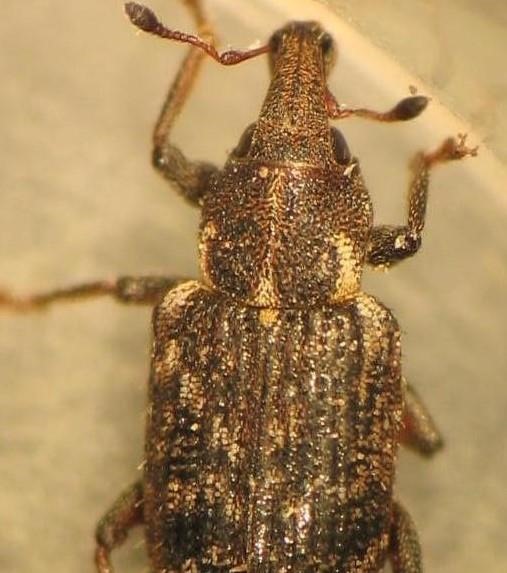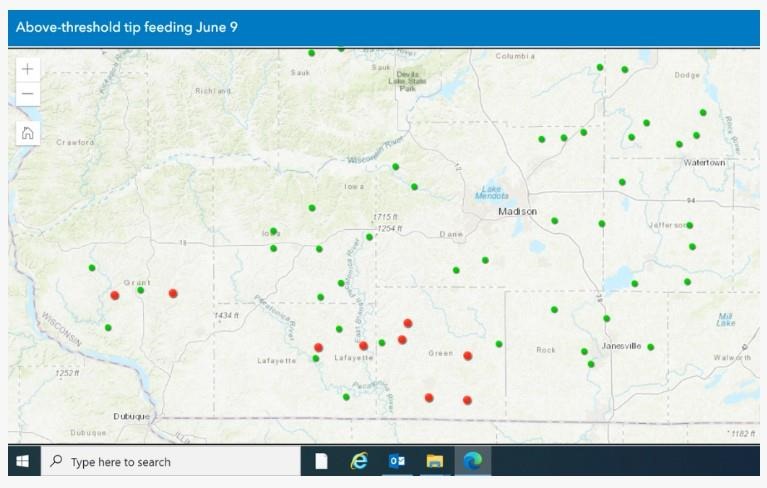By Ben Mcgraw and Danny Kline
Annual bluegrass weevil (ABW), Listronotus maculicollis Kirby, is a primarily a pest of short-cut annual bluegrass (Poa annua) and creeping bentgrass (Agrostis stolonifera) turf (1.3 cm or less) found on golf course greens, tees, fairways, and collars. The weevil's current range extends from western North Carolina to Prince Edward Island, west to Ohio and Ontario. Infestations have most recently been detected in Arkansas (2017), Kentucky (2018), and Wisconsin (2020).
Typical ABW damage begins to show up on the edges of golf course tees, collars and approaches, and fairways in mid to late May. The damage can easily be mistaken for dry spots, or wilt. Damage on or near P. annua putting surfaces may often be mistaken for anthracnose. The damage quickly spreads as the larvae continue to feed on the roots and crowns of the annual bluegrass plants.
Identification
Adults
ABW adults average about 3.6- 4.5 mm in length and resemble small billbugs. Their antennae are attached near the apex of the snout. Mature adult weevils are generally mottled tan to black in color, with fine hairs and yellow-brown and grayish scales. As the adults grow older, the hairs and scales wear off making them appear shiny or jet black.

Annual bluegrass weevil adult
Egg
Annual bluegrass weevil eggs are initially pale yellow, turning to black as they near hatch. They are oblong, approximately three times longer than they are wide, and average about 0.8 to 0.25 mm. Adult females chew a notch in the stem of the plant and deposit eggs singly or in small batches between the leaf sheath and stem. Eggs may also be deposited loosely or outside of the plant in ultra-low mown areas (< 2.5 mm).
Larvae
Annual bluegrass weevil larvae possess five larval instars. Larvae are legless and uniform in width or shaped like a grain of rice. Larvae are cream-colored with orange-brown head capsules and range from 1⁄25 to 1⁄6 inches long. The larvae are stem borers through the first three instars. Fourth- and fifth-instar larvae are too large to fit within the stem of the turfgrass plant. These larvae feed externally on the crown and stem of the plant. Large populations (> 400/m2) are capable of causing considerable turfgrass damage.
General Life History
Annual bluegrass weevil overwinter as adults in protected areas (under leaf litter in wood lines, tall grasses, etc.) surrounding short-mown playing surfaces. In the spring, adults walk out of overwintering locations towards short mown areas. By the time that Forsythia spp. have lost 50% of their petals or flowering dogwood and eastern redbud are in full bloom, all adults will have left their overwintering sites. Once most of the adult population has emerged, they begin to mate and lay eggs. A disproportionate amount of eggs are found on the edges of fairways, tee boxes, collars, and approaches in spring. These eggs then hatch into the larvae, which then begin to feed, causing extensive damage. In late June and early July, after a brief pupation period, adults of the first generation emerge to feed, mate, and lay eggs to start a new cycle, producing a second generation. Second- and third-generation larval populations are typically not as dense as the first generation. However, damage may be as severe if not worse as heat stress may reduce the tolerance of affected turfgrass stands during early to mid-July and early August in Pennsylvania.

Annual bluegrass weevil larval stages
Monitoring
Adults
Adults' activity can be monitored through several different methods. On warm spring days (> 10o C or 50o F), adults can be observed walking on short mown surfaces. Research at Penn State has indicated that adult activity on top of the turfgrass canopy is greatest between 18-24o C (64- 75o F). Adults can also be collected along with clippings when mowing putting greens mowers. Research has demonstrated that a high percentage will survive mowing. Therefore, it is important to disperse clippings away from high-valued turf stands in spring.
A disclosing solution (soapy water) can flush adults out of the thatch-soil to the surface where they can be counted and collected. Apply 1-2 fl oz of lemon-scented dish soap in a 5 gal bucket with water. Stir the solution and pour over the turf. ABW adults make take up to 15-20 minutes to emerge on the tip of the leaf blades.
Plant phenological indicators can be useful in estimating peak adult activity. Forsythia has been used for pre-emergent weed control timing, but it can also be used to indicate ABW movement from overwintering sites. When forsythia is in full bloom, ABW adults are beginning to move out of their overwintering sites toward short turf areas. When forsythia has lost half of its yellow petals (1/2 green, ½ gold stage) most of the adults have moved out of the overwintering sites and should be at peak densities on playing surfaces. The optimum time to apply an adulticide (e.g. pyrethroid, organophosphates), would be at this time.
Pitfall traps, especially linear pitfall traps are also an excellent way of monitoring adult activity in spring or timing the movement of adults from overwintering sites. A pitfall trap can be as simple as a plastic cup, set into the soil. The top of the cup or opening of the trap is set level with the thatch-soil interface to allows the adults to fall into the traps while walking. Partially filling the cup with soapy water will ensure that they cannot escape once inside the trap. Adult ABW can be removed and counted every few days to a week. A linear pitfall trap consists of a three- to four-foot-long piece of 5 to 7.5 cm (2 to 3") PVC pipe that has a slit cut into the top of it. This is also set into the ground level with the turf. One end will be capped and the other leads into the traditional pitfall trap, like the one mentioned above. The trap can collect insects over a larger area than the traditional pitfall trap. Adults will walk towards the trap if the pipe is slightly sloped towards the cup.
Larvae
Larvae and pupae are most effectively sampled by taking a soil-turf core. A golf course cup (hole) cutter works very well for this method and allows for easy calculations of the number of larvae/pupae to units of area (# per core × 10 =~ # per sq ft). A core is taken, down to a depth of about 4 inches. As you begin to break the plug up, the larvae will fall out of the plug and can be counted. Early instar larvae require placing the soil and turf into a saturated saline solution (table agriculture added to lukewarm water) to irritate the larvae from the plant. Break the plug into four equal pieces and put each piece into a quart or comparably sized container containing the saline solution. The salt water makes the larvae extremely buoyant and they float to the surface. ABW larvae may take upwards of 1 hour to be extracted from the plant. A magnifying lens may be required to see the small larvae.
Control Strategies
Controlling ABW presents an annual challenge for golf course superintendents throughout the northeast. But today, we have more control options, and more information available to us than ever before. Staying on top of this new information is a key step towards the management of this golf course pest.
Non-chemical-cultural control
There are several cultural methods that may help ease ABW populations. First, many adult weevils can be collected in the mowing baskets when mowing the putting surface. In a study conducted at Penn State University, 35-40% of adults were removed when mowing putting greens at 0.100" (2.5 mm). The effect was diminished with increased mowing height, with minimal effect at collar, tee box, and fairway heights-of-cut. Clippings from putting surfaces should be removed (especially during peak adult activity periods) and composted or destroyed.
The use of brushes or groomers and rolling can also reduce weevil populations. Rolling of golf greens is typically done to increase green speed, or how fast the ball rolls on the turf. These heavy, vibrating rollers can crush adults during the rolling process. Soft bristle groomers have been shown to better than hard bristles, though both are capable of improving the removal of adults with just mowing alone.
Biological control
No specific natural enemies have been isolated from ABW populations, though generalist parasitic nematodes and fungi have been shown to impact populations. Late spring applications of a parasitic nematodes (e.g. Steinernema carpocapsae, S. feltiae, and Heterorhabditis bacteriophora) have shown to be effective in reducing larval populations when timed with larval populations entering the soil. However, field trials have demonstrated that larval control may be lessened with increasing larval densities.
Chemical control
Preventive
Preventive chemical control strategies are aimed at controlling adult populations before they have a chance to lay eggs. Several broad-spectrum (non-selective), contact insecticides can reduce egg laying when timed with peak adult activity. All of these products have minimal residual activity. Overuse of pyrethroids has led to the development of cross-resistance (i.e. decrease in sensitivity to active ingredients in the pyrethroids) and multiple-resistant populations (i.e. decrease in sensitivity to non-pyrethroid classes) in some areas of the northeastern United States.
Curative
Curative control is aimed at the larvae. All larvicides work best when timed when most of the larvae are entering the soil. Only cyantraniliprole and clothianidin have residual activity and can be applied slightly prior to this timing.
| Table | IRAC Code | Class | Active ingredient | Trade Name |
|---|
| Preventive (Adulticides) | 1A | Organophosphate | Chlorpyrifos | Dursban |
| Preventive | 1A | Organophosphate | Acephate | |
| Preventive | 2B | Pyrethroid | bifenthrin | Talstar |
| Preventive | 1A + 4 | Combination products | Acephate + imidacloprid | Avatar |
| Preventive | 2B + 4 | Combination products | Zeta cypermethrin + bifenthrin + imidacloprid | |
| Preventive | 2B + 4 | Combination products | Bifenthrin + chlothianidin | Triple Crown |
| Preventive | 2B + 4 | Combination products | Bifenthrin + chlothianidin | Aloft |
| Curative (larvicides) | 1A | Organophosphate | trichlorfon | Dylox |
| Curative | 4 | Neonicotinoid | clothianidin | Arena |
| Curative | 5 | Spinosad | spinosyn | MatchPoint |
| Curative | 22 | Oxadiazine | indoxacarb | Provaunt |
| Curative | 28 | Anthranilic diamide | Cyantraniliprole | Ference |
| Curative | 28 | Anthranilic diamide | Tetraniliprole | Tetrino |
Warning
The impact of several classes of insecticides on pollinating insects such as honey bees and native bees is a cause for concern. Because they are systemic chemicals absorbed into the plant, some of these products can be present in pollen and nectar, making them toxic to pollinators that feed on them.
Pesticides are poisonous. Read and follow directions and safety precautions on labels. Handle carefully and store in original labeled containers out of the reach of children, pets, and livestock. Dispose of empty containers right away, in a safe manner and place. Do not contaminate forage, streams, or ponds.
Source : psu.edu